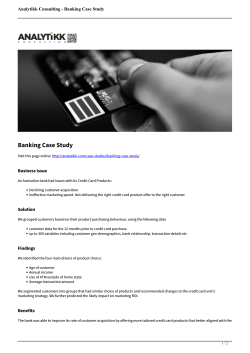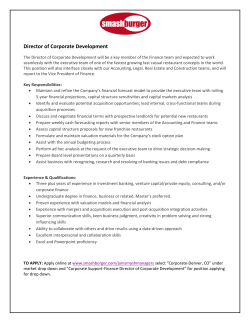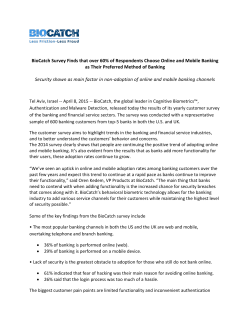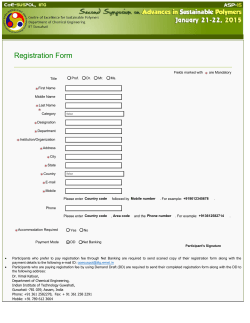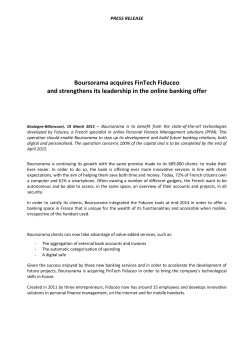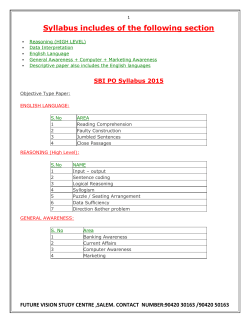
Document
ISSN-2349-1841(Online) Volume 1, Issue 2, March 2015 International Journal of Research Development & Innovation (IJRDI) Research Paper Available online at: www.ijrdi.com A Case Study of the Impact of E-Banking in Remote Area Naveen Singh Gill (naveengill31@gmail.com) Aman Kumar Sharma (sharmaas1@gmail.com) Abstract: In the present era rapid development in the area of technology has affected all other areas. Especially where the computer technology is concerned one can say that there is no other field that remains unaffected with the growth of computer technology. This need has inspired banking sector to add new technologies which also influence customer services, including ebanking. E-banking is the major task or field in today banking sector. Today banking is very easy in metro areas and urban areas but this study mainly concerns the case study of e-banking in remote areas. The literature survey is done for Reserve bank of India and impact of liberalization on banking system, IT in Indian Banking Sector, Competition In Banking Sector, Customer Services or Facilities. The main objective in this is to study the facilities of ebanking in remote area of Kinnaur district of Himachal Pradesh where road connectivity, electricity problem, transportation problem, altitude problem and many more. To study best e-banking facilities the different banks SBI, PNB, UCO, HPSCB of Kinnaur district of Himachal Pradesh are compared. An attempt is made to know the reason behind the success or failure of the banks in the remote region of Kinnaur district. The data was collected, organized and analyzed. 1. INTRODUCTION Bank is a lawful organization, which accepts deposits that can be withdrawn on demand. It All Rights Reserved also lends money to individuals and business houses that need it. A bank is a financial intermediary and money creator that creates money by lending money to a borrower, thereby creating a corresponding deposit on the bank's balance sheet. Due to their importance in the financial system and influence on national economies, banks are highly regulated in most countries. Most nations have institutionalized a system known as fractional reserve banking, central banking, under which banks hold liquid assets equal to only a portion of their current liabilities. Banks give two assurances to the depositors – a. Safety of deposit, and b. Withdrawal of deposit, whenever needed. I. Bank “An establishment for custody of money, which it pays out on customer's order.” Banks provide funds for business as well as personal needs of individuals. They play a significant role in the economy of a nation. Let us know about the role of banking: [7] It encourages savings habit amongst people and thereby makes funds available for productive use. It acts as an intermediary between people having surplus money and those P a g e | 77 Naveen Singh et.al... www.ijrdi.com International Journal of Research Development & Innovation (IJRDI) Volume 1, Issue 2, March 2015, Pg. 77-82 requiring money for various business activities. It facilitates business transactions through receipts and payments by cheques instead of currency. It provides loans and advances to businessmen for short term and longterm purposes. It also facilitates import export transactions. It helps in national development by providing credit to farmers, small-scale industries and self-employed people as well as to large business houses which lead to balanced economic development in the country. It helps in raising the standard of living of people in general by providing loans for purchase of consumer durable goods, houses, automobiles, etc. II. Banking Features 1. Dealing in Money: Bank is a financial institution which deals with other people's money. 2. Individual/Firm/Company: A bank may be a person, firm or a company. A banking company means a company which is in the business of banking. 3. Acceptance of Deposit: A bank accepts money from the people in the form of deposits which are usually repayable on demand or after the expiry of a fixed period. It gives safety to the deposits of its customers. 4. Giving Advances: A bank lends out money in the form of loans to those who require it for different purposes. 5. Payment and Withdrawal: A bank provides easy payment and withdrawal facility to its customers in the form of cheques and drafts, it also brings bank money in circulation. This money is in the form of chequesn drafts, etc. 6. Agency and Utility Services: A bank provides various banking facilities to its customers. They include general utility services and agency services. 7. Profit and Service Orientation: A bank is a profit seeking institution having service oriented approach. All Rights Reserved 8. Ever increasing functions: Banking is an evolutionary concept. There is continuous expansion and diversification as regards the functions, services and activities of bank. 9. Connecting Link: Abank acts as a connecting link between borrowers and lenders of money. Banks collect money from those who have surplus money and give the same to those who are in need of money. 10. Banking Business: A bank's main activity should be to do business of banking which should not be subsidary to any other business. 11. Name Identity: A bank should always add the word “bank” to its name to enable people to know that it is a bank and that it is dealing in money. 2. E-BANKING (ELECTRONIC BANKING) With advancement in information and communication technology, banking services are also made available through computer. Now, in most of the branches you see computers being used to record banking transactions. Information about the balance in your deposit account can be known through computers. “E-banking is defined as the automated delivery of new and traditional banking products and services directly to customers through electronic, interactive communication channels. E-banking includes the systems that enable financial institution customers, individuals or businesses, to access accounts, transact business, or obtain information on financial products and services through a public or private network, including the Internet.” [25] • Automated Teller Machine Banks have now installed their own Automated Teller Machine (ATM) throughout the country at convenient locations. By using this, customers can deposit or withdraw money from their own account any time. Transfer of amounts. Balance enquiry. • Debit Card Banks are now providing Debit Cards to their customers having saving or current account in the banks. The customers can use this card for purchasing goods and services at different places in lieu of cash. The amount paid through debit P a g e | 78 Naveen Singh et.al... www.ijrdi.com International Journal of Research Development & Innovation (IJRDI) Volume 1, Issue 2, March 2015, Pg. 77-82 card is automatically debited (deducted) from the customers’ account. • Credit Card Credit cards are issued by the bank to persons who may or may not have an account in the bank. Just like debit cards, credit cards are used to make payments for purchase, so that the individual does not have to carry cash. Banks allow certain credit period to the credit cardholder to make payment of the credit amount. Interest is charged if a cardholder is not able to pay back the credit extended to him within a stipulated period. This interest rate is generally quite high. • Net Banking With the extensive use of computer and Internet, banks have now started transactions over Internet. The customer having an account in the bank can log into the bank’s website and access his bank account. He can make payments for bills, give instructions for money transfers, fixed deposits and collection of bill, etc. • Phone Banking In case of phone banking, a customer of the bank having an account can get information of his account, make banking transactions like, fixed deposits, money transfers, demand draft, collection and payment of bills, etc. by using telephone . As more and more people are now using mobile phones, phone banking is possible through mobile phones. In mobile phone a customer can receive and send messages (SMS) from and to the bank in addition to all the functions possible through phone banking. Balance enquiry. Automatic/computerized transactions. Transfer of funds. 3. REGION Kinnaur District: Kinnaur is one of twelve administrative districts in the Indian state of Himachal Pradesh, India. The district is divided into three administrative areas – Pooh, Kalpa, and Nichar – and has five tehsils . The administrative headquarters of Kinnaur district is at Reckong Peo. From here Kinnaur Kailash, considered to be the abode of Lord Shiva, can be viewed. As of 2011 it is the second least populous district of Himachal Pradesh (out of 12), after Lahaul and Spiti, but there are nine vital languages are spoken in the district. Location of Kinnaur District Kinnaur, surrounded by the Tibet to the east, is in the northeast corner of Himachal Pradesh, about 235 km (146 mi) from the state capital, Shimla. It has three high mountains ranges, namely, Zanskar, Himalayas and Dhauldhar that enclose valleys of Sutlej, Spiti, Baspa and their tributaries. The slopes are covered with thick wood, orchards, fields and picturesque hamlets. In 2011, Kinnaur had population of 84,121 of which male and female were 46,249 and 37,872 respectively. In 2001 census, Kinnaur had a population of 78,334 of which males were 42,173 and remaining 36,161 were females. Kinnaur District population constituted 1.23 percent of total Maharashtra population.[28] Altitude: A mountainous area, ranging in altitude from 2,320 to 6,816 metres (7,612 to 22,362 ft), Kinnaur is one of the smallest districts in India by population. It is famous for the Kinner Kailash, a mountain sacred to Hindus, close to the Tibetan border. Total area of Kinnaur: 6401 sq km.[29] Climate Most of Kinnaur enjoys a temperate climate due to its high elevation, with long winters from October to May, and short summers from June to September. The lower parts of the Sutlej Valley and the Baspa Valley receive monsoon rains. The upper areas of the valleys fall mainly in the rainshadow area. These areas are considered to be arid regions, similar to the climate of Tibet. Central Asian landscape are common.[29] Road Connectivity In view of the high potential in agricultural and horticulture activity road connectivity is the main issue in Kinnaur district. There is huge increase in road network, but the conditions of road are not good. The geography of Kinnaur presents considerable challenge to the development of transport infrastructure. Nevertheless, the district has made significant progress in road connectivity in the last few decades. Transportation takes place by roads only. There is no direct flight or rail service to Kinnaur and the nearest Airport is Shimla which can be reached from Delhi. Financial Status of Kinnaur All Rights Reserved P a g e | 79 Naveen Singh et.al... www.ijrdi.com International Journal of Research Development & Innovation (IJRDI) Volume 1, Issue 2, March 2015, Pg. 77-82 The financial status of Kinnaur district depends upon Agriculture and Horticulture. In Kinnaur district, it is observed that per captia is very high as compare to other districts of Himachal Pradesh. The economy of Kinnaur mainly depends on its fruits production. The climate of Kinnaur is cold and dry and is ideally suited for the production of temperate fruits and fruits that can be dried. Apple is an important fruit crop of Kinnaur with regards to average production, economic value and above all popularity. It will be useful to analyses the trend of apple production of Kinnaur district. The people of district are rich but there is lack of facilities in banking sector for people of rural areas. The banks are not at every village and people are still far away from banking services due to lack of facilities given below: Banking facilities. ATM facilities. Internet connectivity. Road connectivity. Electricity problem. Lack of hospitals. Economic exchange. E-banking. 4. PROBLEMS FACED IN REMOTE AREAS Low recovery of loans in rural areas. A transaction in remote areas due to poor internet connectivity. In remote, hilly and sparsely populated areas with poor infrastructure. ATM penetration is low and other channels such as Phone and Internet Banking are non-existent. Increase in reservoir or of rivers flooding their banks because of heavy rains. The state of Himachal has been facing flood problem. Due to poor connectivity and power cuts during peak hours in the remote areas. 5. ANALYSIS In order to evaluate the bans of the region, the various facilities provided by the bank are evaluated. The ban customers are always All Rights Reserved interested in the facilities provided by the bank. Bank having better facilities would be more liked by the customers. The common features which were checked were number of branches, number of ATMs, total amounts deposited and many more. Such data is presented in the table. Further the figures presented in the table are updated up to 31st December,2014. Sr Particulas SBI No PNB UCO HPSCB 1 Number of 9 Branches 4 9 16 2 Number of ATMs 9 4 4 2 3 Number of Accounts 16245 24600 29473 71399 4 Deposit 371 Amounts( Rs in Crore) 114 127 350 5 Ratio of 238378 deposit amount per customer(i n Rs) 46341 43090 49020 6 Advances Accounts 2081 3177 7373 7 Advances 162 Amounts( Rs in Crore) 44 48 133 8 Ratio of 245566 advance amount per customer(i n Rs) 211436 151086 6597 180363 P a g e | 80 Naveen Singh et.al... www.ijrdi.com 9 First branch 19th opened in year December ,1977 10 Oldest branch Pooh International Journal of Research Development & Innovation (IJRDI) Volume 1, Issue 2, March 2015, Pg. 77-82 15th 22nd June,197 July,1976 9 10th November, 1960 23 Bill payments Recko- Sangla ngpeo Kalpa Table 7.1 Features of different banks in Kinnaur district Yes No No No (Chinni 6. CONCLUSION 11 Number of 52 employees 46 12 Saving interest rates 4.00% 4.00% 4.00% 4.00% 13 Internet banking Yes Yes Yes No 14 Mobile banking Yes No No No 15 e-tax payments Yes Yes No No 16 SMS Alerts Yes Yes Yes Yes 17 Website Yes advertisem ent Yes Yes No 18 e-mail Yes advertisem ent Yes Yes No 19 Share Trading Yes Yes 20 Customer satisfactio n Max 21 Money transfer Yes 38 108 In the case study of the four prominent banks (SBI, PNB, UCO, HPSCB) of the remote region of Kinnaur district, It is concluded that in spite of being the oldest bank in Kinnaur district and having more branches than other banks, HPSCB still lacks behind in term of all over ratio of deposit amount per customer. SBI having less customers but deposit is maximum due to internet banking, SMS banking, online fund transfer facilities and many more. The customer of that area wants bank services at their homes because of lack of transportation and road connectivity is the major problem. Due to this factor customer is preferring SBI rather than other banks. From the analyses of four banks SBI is giving best service of E-Banking in Kinnaur district. PNB has very less branches in district, UCO bank has nine branches but has less ATMs and E-Banking facilities. So people of Kinnaur district are following SBI bank more and deposit their money because of more ATMs and E-banking facilities. References [1] No No [2] Min Min Min [3] 22 Internation Yes al money transfer Yes Yes Yes [4] Yes Yes No [5] [6] All Rights Reserved Ananthakrishnan G,” Customer Service in Banks”, Vinimaya, Vol. 25, No.3, 2005. Balasubramanya S., “IT wave breaks over banking”, Vikalpa, Vol. 28, No.3, July 2002. Debashish Sathya Swaroop and Mishra Bishnu Priya "E-Banking In India – Major Development and Issues", Pranjana, Vol. 6, no.1. July 2003, pp 18. Demand N H, “The Mediterranean Context of Early Greek History”, John Wiley & Sons, 2012. Fagan Brian M., “World prehistory: a brief introduction”, Prentice Hall, 2002. Gulati V. P.,” Information Technology Application in Indian Banking: Better P a g e | 81 Naveen Singh et.al... www.ijrdi.com [7] [8] [9] [10] [11] [12] [13] [14] [15] [16] [17] [18] International Journal of Research Development & Innovation (IJRDI) Volume 1, Issue 2, March 2015, Pg. 77-82 Late than Never!”, “NewsLetter”, Vol. 6, No. 3, July 1996. Iyengar Vijayaragvan, ”Introduction to banking- Reforms in financial sector”, Excel books, New Delhi, 2009. Liverani Mario” The Ancient Near East: History, Society and Economy”, Routledge, ISBN 1134750846, 4 December 2013. Kamakodi N., M Basheer Ahmed Khan, “Customer Expectations and Service Level in E-Banking Era: An Empirical Study”, The ICFAI University Journal of Bank Management, Vol-7 Issue 4, November 2008. Krishnan Mahalaxmi, “Rural Banking Challenges in India”, International Journal Of Scientific Research, Vol-1 Issue-7, ISSN 2277-8179, December 2012. Kunkalienkar Manoj,“IT in Banking 2003 (Special) Perspectives of CEO’s: Banking Software Companies”, ICFAI University Journal of Bank Management, Vol-7, issue 35, August 2006. Mehta B.K. ,”Principles of Money and Banking ”, Motilal Publication, 2000. Mishra A. K. , Rao A. R. , “Sprightliness of Urban Cooperative Banks : A Study”, New Century Publications, New Delhi, 2008. Muraleedharan D. “Modern Banking”, Eastern Economy Edition , PHI Publications, 2009. Rajashekhara K. S., “Application of IT in Banking”, Yojana, July 2004. Uppal R. K., “Customer Perception of EBanking Services of Indian Banks: Some Survey Evidence”, The ICFAI University Journal of Bank Management, Vol-7 Issue-1 February 2008. [20] Vallabh Gourav, Chatrath Suraj, ” Role of Banks In Agriculture & Rural Development ”, Chartered Financial Analyst, The ICFAI University Press, Hyderabad, February, 2006. [21] Vij Madhu, “The New World of Banking: A Paradigm shift”, Journal of Managemen Management Research, Vol.3, December 2003. [19] Rowman, Littlefield, “The Origins of the Modern World: Fate and Fortune in the Rise of the West”, 7 December 2012. Seshaiah S. Venkata, Vunyale Narender, “Factors Affecting Customers’ Choice of Retail Banking”, ICFAI University Journal of Bank Management, Vol- 6, issue 1, March 2007. Shannak Rifat O.,”Key Issues In EBanking Strengths And Weaknesses: The Case Of Two Jordanian Banks”, European Scientific Journal, Vol.9, No.7 ISSN: 1857 – 7881 , March 2013. All Rights Reserved P a g e | 82
© Copyright 2025



